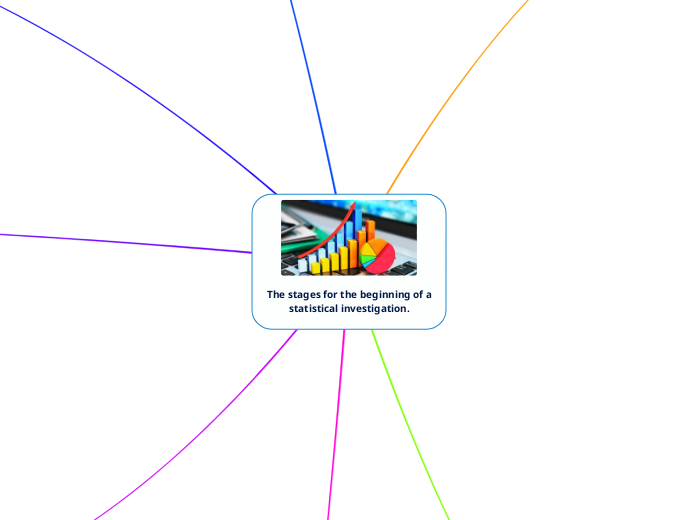The stages for the beginning of a
statistical investigation.
Organization.
Contracting of auxiliary services.
Staff training.
Printing of the form.
Advertising plan.
Formulation of the plan.
Geographic works.
Consulting.
Preliminary studies.
Publication
Final phase of the investigation, proposes the total result of the study.
A copy of the form used in the collection may be included in the report.
Brief exposition of the adopted methodology.
Selection process of information and collection units.
Design and sample size.
hypotheses to be tested.
Research objective.
Problem Statement
Analysis and interpretation.
Professor John W. Best in his book gives us a possible guide to the analysis, suggesting the following points:
Summary and conclusions.
Are the procedures described in detail?
Is the problem reframed?
Data analysis.
Is the exposition of the text concise and clear?
Is it appropriate to use tables and figures?
Procedures used.
Is this design suitable?
Is the experimental design described in detail?
Review of related literature
Are important findings highlighted?
Is it of adequate width?
The problem
Is it well defined?
Is it clearly established?
Title
Doesn't it promise more than the studio can deliver?
Is it clear and concise?
The methodology phase can be said to contain two aspects:
Analysis and technical evaluation according to the nature of the investigation.
Analysis and statistical evaluation of the results.
Tabulations or processing.
It can be manual, mechanical or computerized and your choice will depend on:
Of time and resources, whether financial or available equipment.
Of the number of questions that the form has.
The number of forms to be used.
Criticism and coding.
The object of the criticism is to classify the primary material that precedes the same investigation, into three groups:
Uncorrectable or disposable material.
Incorrect but correctable material.
good stuff
It is a set of operations to review and correct the information collected.
That allows us to group and process it, in such a way that it facilitates the elaboration of.
Analysis, necessary in the publication.
Graphics.
Paintings.
Planing .
The research budget.
Materials and equipment.
Publication.
Systematization.
Field work (collection).
Statistical material
Forms
Collective
Individual
Printed material
Records.
Registration sheets.
Circulars.
Instruction sheets.
Newsletters
Forms or questionnaires.
investigation procedures
What characteristics should the research have?
Under what forms will we collect the data?
Utility.
Simple.
Clarity and publication.
Source of information.
So far we have analyzed what you want to investigate and the reason for that investigation.
Hint
They are the concrete results of the use of primary sources
direct
These types of sources contain original information, that is, they are first-hand
Object of the investigation.
In the project, when analyzing what it is or what we are going to investigate, we propose:
Limit the researchable object.
Determine the feasibility of your research.
Determine its quantitative and qualitative nature.
Define the object or purpose of the investigation
Data collection.
Summary of planning a survey.
Preparation of Conclusions
Data analysis
Data Management Organization
Field Work Organization
Pilot test
Selection and Training of Field Researchers
Elaboration or Preparation of the Measurement Instrument
Choice of Measurement Method
Sampling Design Selection
Selection of the Sampling Frame
Target Population Selection
Definition of the problem and Establishment of Objectives
The harvesting stage comprises several aspects.
Control over the quality of the information collected.
Control of the number of forms collected.
The collection itself.
Distribution of the collection material or instrument.
characters
Qualitative
Quantitative
Statistical units
Information sources.
secondary sources.
primary sources
Types of surveys
Type
structural
conjunctural
by interview
Mixed form:
By phone
by mail
Delivered by interviewers.
pickups
by interviewers.
about facts
about opinions
Poll
census
unitary or personal
Ready
Criterion
Due to the nature of the investigation
Attending to the collection system
Due to the nature of the investigation
statistics
By proportion of the population
respondent
Because of the form that the questionnaire takes
structural
conjunctural
Kind of questions
Closed questions
Validity
trustworthy
Operative
Data collection methods
Experimentation.
Interviews with study subjects
surveys
Fundamental characteristics of a survey
It makes it possible for social research to get to the subjective aspects of members of society.
It allows a massive application that through a sampling system can be extended to an entire nation.
It is a method prepared for research.
The survey is a non-direct observation of the facts through what interested parties express.
Observation.

